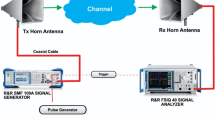Abstract
Vertical plane launching ray tracing method has been applied for a real urban scenario and the delay characteristics of received signals in the overall coverage area have been extracted. Using these parameters, an equivalent channel power delay profile (ECPDP) has been introduced for the overall coverage area. For a millimeter wave wireless OFDM system, the optimum guard interval length which maximizes the mean of signal to interference and noise ratio has been simulated. Also, using the proposed ECPDP, the optimum guard interval length has been analytically extracted and compared with the simulated one.
Similar content being viewed by others
References
Prasad R., Ruggieri M. (2003) Technology trends in wireless communications. Artech House, Boston, London
Huish, W., Johnson, I. T., Li, T. A., & Nicholls, M. J. (1985). MM-wavelength microcellular mobile systems: A solution to spectrum congestion for high user densities. In 3rd IERE conference on land mobile radio, pp. 47–53.
Steele, R. (1983). Digital microcellular radio. In Proceedings of the conference on cellular mobile radio, SERC.
Thomas H. J., Siqueira G. L., Cole R. S. (1987) MM-waves show merit for mobile cellular radio. Microwaves and RF Journal 26(2): 67–70
Giannetti F. (1997) Capacity evaluation of a cellular CDMA system operating in the 63–64-GHz band. IEEE Transactions on Vehicular Technology 46(1): 55–64
Strohmer T., Beaver S. (2003) Optimal OFDM design for time-frequency dispersive channels. IEEE Transactions on Communications 51(7): 1111–1122
Hara S., Prasad R. (2003) Multicarrier techniques for 4G mobile communications. Artech House, Boston, London
Atamanesh M., Farzaneh F. (2010) Precision enhancement in ETSI-Hata propagation model tuning using experimental data in a dense urban area. International Journal of Communication Systems 23(1): 101–108
Catedra M. F., Perez J., Saez de Adana F., Gutierrez O. (1998) Efficient ray-tracing techniques for three-dimensional analyses of propagation in mobile communications: Application to picocell and microcell scenarios. IEEE Antennas and Propagation Magazine 40(2): 15–28
Schaubach K. R., Davis N. J., Rappaport T. S. (1992) A ray tracing method for predicting path loss and delay spread in microcellular environments. 42nd IEEE Vehicular Technology Conference 2: 932–935
Erceg V., Rustako A. J. Jr., Roman R. S. (1994) Diffraction around corners and its effects on the microcell coverage area in urban and suburban environments at 900 MHz, 2 GHz, and 6 GHz. IEEE Transactions on Vehicular Technology 43(3): 726–766
Liang G., Bertoni H. L. (1998) A new approach to 3-D ray tracing for propagation prediction in cities. IEEE Transactions on Antennas and Propagation 46(6): 853–863
Beckmann P., Spizzichino A. (1987) The scattering of electromagneticWaves from rough surfaces. Artech House, Norwood, MA
RECOMMENDATION ITU-R P.676-6. (2005). Attenuation by atmospheric gases.
Luebbers R. (1984) Finite conductivity uniform GTD versus knife edge diffraction in prediction of propagation path loss. IEEE Transactions on Antennas and Propagation 32(1): 70–76
Hammoudeh A. M., Garcia Sanchez M., Grindrod E. (1999) Experimental analysis of propagation at 62 GHz in suburban mobile radio microcells. IEEE Transactions on Vehicular Technology 48(2): 576–588
Pantos G. D., Kanatas A. G., Constantinou P. (2003) Performance evaluation of OFDM transmission over a challenging urban propagation environment. IEEE Transactions on Broadcasting 49(1): 87–96
Le Khoa N. (2008) Bounds on inter-carrier interference power of OFDM in a Gaussian scattering channel. Wireless Personal Communications 47(3): 355–362
Le Khoa N. (2010) BER of OFDM in Rayleigh fading environments with selective diversity. Wireless Communications and Mobile Computing 10(2): 306–311
Le Khoa N. (2009) Performance bounds on BER of OFDMA with pulse shaping and maximal ratio combining diversity. European Transactions on Telecommunications 20(5): 487–493
Author information
Authors and Affiliations
Corresponding author
Rights and permissions
About this article
Cite this article
Atamanesh, M., Farzaneh, F. A Proposed Equivalent Channel Power Delay Profile for a Millimeter Wave Wireless OFDM System and Optimum Guard Interval Evaluation in a Built-Up Area Propagation Scenario. Wireless Pers Commun 69, 1223–1239 (2013). https://doi.org/10.1007/s11277-012-0631-5
Published:
Issue Date:
DOI: https://doi.org/10.1007/s11277-012-0631-5




